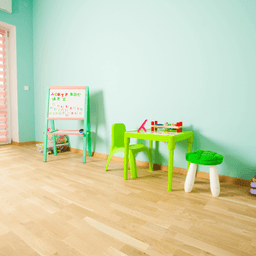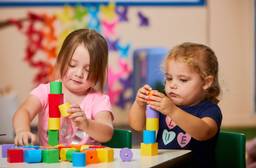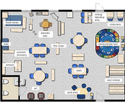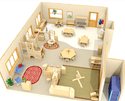How to design a daycare classroom floor plan
When it comes to setting up your daycare classroom, figuring out the floor plan can be a big struggle. You might be asking yourself:
- Where should I put the blocks?
- If my room is too small, how am I supposed to have learning centers?
- Where can I put my dramatic play area?
- What learning materials should I have?
All of these are great questions, and we will discuss what learning centers to have, where they should go, and what should be in them all without losing your own aesthetic as an educator.
Why should I have learning centers?
Learning centers are important to the early childhood classroom because they allow children to safely and freely explore at their own pace. Engagement increases when children have choices in how they learn and play. This allows for small group interaction as well as individual exploration. It also allows for varying levels of learning, depending on what you have in each center. Learning centers help educators stay organized as well as keep learning fun! If you operate with themes and units, it can be easy to organize with learning centers. Ultimately, learning centers foster play and creativity, which is what every early childhood classroom should do.
What learning centers should I have?
It is up to each individual educator as to what learning centers you should have, but according to ECERS (Early Childhood Environment Rating Scale) — an assessment tool used in most daycares in the U.S. — it is important to have the following learning centers in each classroom:
- Language/Reasoning
- Blocks
- Dramatic play
- Art and music
- Science and nature
- Math and manipulatives
- Sand and water
What should be in each learning center?
There are exhaustive lists to refer to where you can see what items should be included in each of the learning centers mentioned above.
The most important thing to know when figuring out your inventory is to make sure that each learning center is diverse, clean, safe, and stocked. Each center should have books, toys, and materials that are diverse in cultures represented. There should also be diversity in ability so that different levels of learning can occur.
All materials should be clean and have no missing or broken parts. Materials should be developmentally appropriate, and if they require supervision, make sure this occurs.
All materials should also be well-stocked. If you have 20 children in your classroom and only one doll in the dramatic play area, that is a problem. For example, the ECERS assessment tool shows that in your blocks center, there should be three types of blocks and all sorts of accessories within the block area to foster a rich and creative learning environment. You cannot simply achieve all of these materials overnight, but be sure to build it over time to offer best practices.
Where should I put each learning center?
When it comes to figuring out placement, there are many free websites that you can play around with to figure out your floor plan. Sites like RoomSketcher, myKaplan Floor Planner, and ConceptDraw are just a few examples of free resources where you can design 2D and 3D floor plans. This can help you give a birds-eye view so that you aren’t overwhelmed when standing in your classroom.
Where you place your learning centers is important. There are centers that are considered quiet, centers that are considered noisy, and centers that are somewhere in the middle that we refer to as “buffers.” Centers like math, reading, and art can be considered quiet centers. Centers like blocks, music, and dramatic play can be considered noisy. Then, centers like science, and sand/water can be considered “buffers.” It’s important to not place quiet centers directly next to noisy centers. It is understandable that some classrooms are small and therefore do not have the luxury of being spaced out, but if you can help it, keep those away from each other. You can also consider having some noisy centers only open when the quiet centers are not being used if needed.
It is also important to place centers not only against walls. You will need to create boundaries using rugs and shelving so that it is obvious where centers end and where another begin. It will also allow for children to not have so much open space that it invites them to run. When creating the boundaries, just be careful of blindspots that shelves and different furniture can create.
What about desks and tables?
Small group structure is the most important and prominent part of early childhood education. Best practices would be that children would be eating, playing and learning all in small groups. There will be times for whole group instruction, but for the most part, children should be working in small groups. There shouldn’t be 20 desks facing the front in a preschool classroom. There also doesn’t need to be seating for 20 children all at one time. Each child should have their own cubby and place for personal belongings, but since children should be doing most things in small groups, it isn’t necessary to have seating for all 20 children at tables and chairs.
There should be small tables throughout the classroom in centers for puzzles, math, writing, etc. There should also be rugs or mats so that children can play nicely on the floor if needed. Large pillows or beanbags in the reading area are necessary. Chairs should be size appropriate and in good condition. If it is possible for you to have separate tables for eating, that is great.
Sample floor plan designs
There are tons of floor plans out there if you do a simple web search. But not all floor plans will be good examples. Look for spacing, organization, and small group setups. Here are a few that are great.
When it comes to daycare floor plans, keep it simple, organized, clean, safe, and fun. Make sure materials are accessible to children in learning centers, and make sure that you store away what you don’t use on a daily basis. Children thrive in clean and organized spaces. When there is clutter, it does not promote a good learning environment. Even if your budget is small, there are inexpensive ways to declutter and organize your space that you can be proud of. This is your second home, so have pride in it and help your children feel welcomed and loved!
Missy is a professor in the early childhood department at Eastern University and director of Victory Early Learning Academy, a childcare center that she started ten years ago. Prior to that, she taught Kindergarten and second grade for a total of 10 years. She has been married to her best friend, Jason, for 18 years, and together they have four beautiful children ages 8, 9, 12 and 13 in the suburbs of Philadelphia, PA. In her spare time, Missy loves to bake, read historical fiction, sing karaoke and travel to Central America on short term missions.
More by Missy
Missy Knechel
June 3rd, 2021
18 mins
Related Articles

The Benefits of Loose Parts Play for Young Children
December 10th, 2025 | Maddie Hutchison








